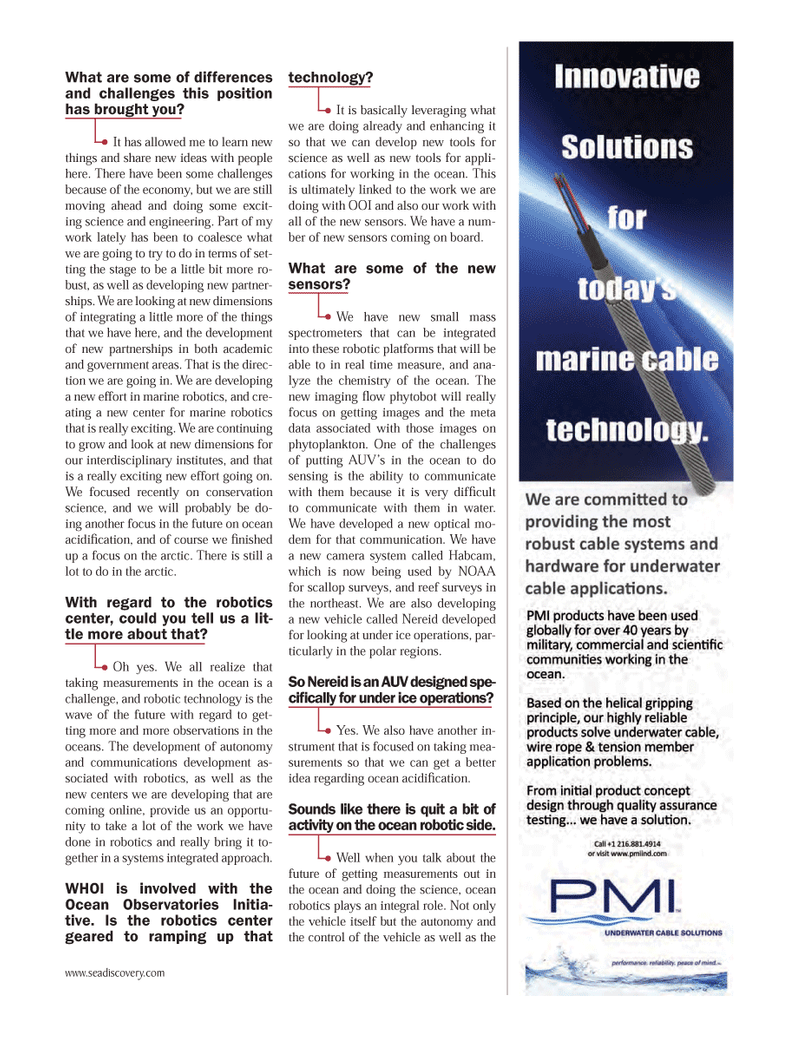
Page 43: of Marine Technology Magazine (September 2012)
Subsea Defense: Protecting Port & Subsea
Read this page in Pdf, Flash or Html5 edition of September 2012 Marine Technology Magazine
What are some of differences and challenges this position has brought you? It has allowed me to learn new things and share new ideas with people here. There have been some challenges because of the economy, but we are still moving ahead and doing some excit- ing science and engineering. Part of my work lately has been to coalesce what we are going to try to do in terms of set-ting the stage to be a little bit more ro-bust, as well as developing new partner- ships. We are looking at new dimensions of integrating a little more of the things that we have here, and the development of new partnerships in both academic and government areas. That is the direc- tion we are going in. We are developing a new effort in marine robotics, and cre- ating a new center for marine robotics that is really exciting. We are continuing to grow and look at new dimensions for our interdisciplinary institutes, and that is a really exciting new effort going on. We focused recently on conservation science, and we will probably be do-ing another focus in the future on ocean acidiÞ cation, and of course we Þ nished up a focus on the arctic. There is still a lot to do in the arctic. With regard to the robotics center, could you tell us a lit- tle more about that? Oh yes. We all realize that taking measurements in the ocean is a challenge, and robotic technology is the wave of the future with regard to get- ting more and more observations in the oceans. The development of autonomy and communications development as- sociated with robotics, as well as the new centers we are developing that are coming online, provide us an opportu- nity to take a lot of the work we have done in robotics and really bring it to-gether in a systems integrated approach. WHOI is involved with the Ocean Observatories Initia- tive. Is the robotics center geared to ramping up that technology? It is basically leveraging what we are doing already and enhancing it so that we can develop new tools for science as well as new tools for appli- cations for working in the ocean. This is ultimately linked to the work we are doing with OOI and also our work with all of the new sensors. We have a num- ber of new sensors coming on board. What are some of the new sensors? We have new small mass spectrometers that can be integrated into these robotic platforms that will be able to in real time measure, and ana-lyze the chemistry of the ocean. The new imaging ß ow phytobot will really focus on getting images and the meta data associated with those images on phytoplankton. One of the challenges of putting AUVÕs in the ocean to do sensing is the ability to communicate with them because it is very difÞ cult to communicate with them in water. We have developed a new optical mo- dem for that communication. We have a new camera system called Habcam, which is now being used by NOAA for scallop surveys, and reef surveys in the northeast. We are also developing a new vehicle called Nereid developed for looking at under ice operations, par- ticularly in the polar regions. So Nereid is an AUV designed spe- ciÞ cally for under ice operations? Yes. We also have another in- strument that is focused on taking mea-surements so that we can get a better idea regarding ocean acidiÞ cation. Sounds like there is quit a bit of activity on the ocean robotic side. Well when you talk about the future of getting measurements out in the ocean and doing the science, ocean robotics plays an integral role. Not only the vehicle itself but the autonomy and the control of the vehicle as well as the www.seadiscovery.com MTR #7 (34-49).indd 43MTR #7 (34-49).indd 439/10/2012 9:46:43 AM9/10/2012 9:46:43 AM

 42
42

 44
44
